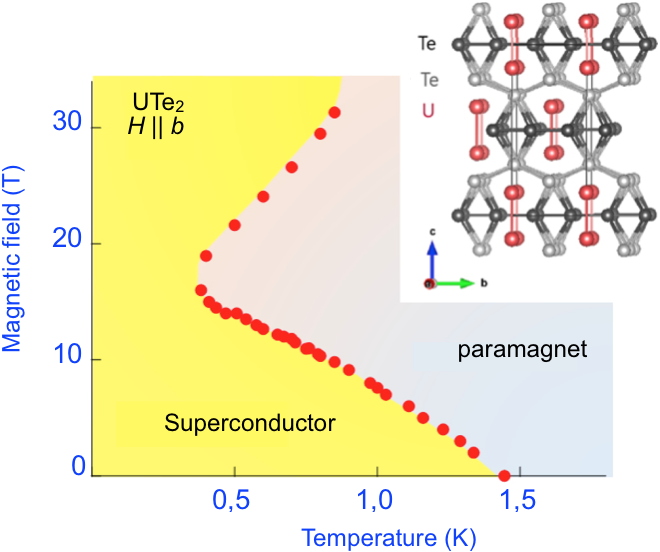Superconductivity is characterized by the absence of electrical resistance and the expulsion of an external magnetic field. This spectacular manifestation of quantum mechanics down to macroscopic scales is well interpreted by the theory of superconductivity developed for simple metals more than 60 years ago. The recent discovery of new families of superconductors with unexpected properties has challenged this understanding.
Researchers at our laboratory are currently studying the compound UTe
2, a superconductor discovered in 2018 by researchers at the University of Maryland (USA). This metal has surprising properties. It becomes superconducting at temperatures below 1.6K. The magnetic field to suppress its superconductivity is anisotropic, which seems natural for a metal with an orthorhombic crystal structure like UTe
2. However, the required field strengths to suppress the superconductivity are much higher than those needed of a classical superconductor. These results show that UTe
2 is a rare "spin triplet" superconductor, where the electrons group together in pairs with their spin oriented in the same direction
[1, 2].
The compound UTe
2 presents another remarkable property. As in a classical superconducting material, the critical temperature for the onset of superconductivity first decreases under the effect of the magnetic field. But, surprisingly, the behavior is reversed for stronger fields: the magnetic field strengthens the superconducting state when it exceeds the threshold of 15T. The critical temperature continues to increase up to exceptionally high field strengths of 35T, ten to one hundred times higher than for conventional materials. Moreover, considering the discovery by American researchers of another superconducting phase of UTe
2 at even higher magnetic field strengths, researchers at our laboratory subjected UTe
2 to pulsed fields at the Laboratoire National des Champs Magnétiques Intenses (LNCMI National Laboratory of Intense Magnetic Fields) in Toulouse. A new superconducting state was then revealed above 45T. This state is maintained until at least 60T. Finally, under high pressure, the researchers also discovered transitions between different superconducting phases, at zero magnetic field and under field.
Until now, scientists believed that superconductivity was weakened to the point of being suppressed by the application of magnetic fields. The described results show that this property is not systematic. The characteristics uncovered by the researchers at our laboratory show how UTe
2 is a remarkable superconductor, with a "spin triplet" state that is extremely rare in nature and particularly interesting because of its intrinsic topological nature. Its totally unexpected properties are the source of a strong motivation to continue its experimental exploration. Their interpretation is also an exciting challenge for the theory.

Figure: Temperature dependence of the critical magnetic field of UTe
2 applied along the crystal b-axis between a metallic and a superconducting phase. The magnetic field enhances the superconductivity from 15T to 35T. The insert shows the orthorhombic structure of UTe
2.